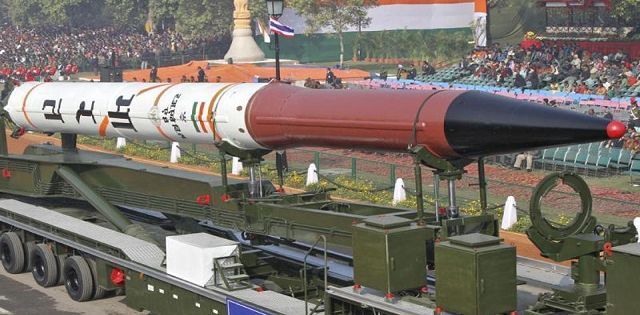CURRENT AFFAIRS
Get the most updated and recent current affair content on Padhaikaro.com
INDIA NUCLEAR POLICY : NO FIRST USE
- IAS NEXT, Lucknow
- 01, Jan 2021

INDIA NUCLEAR POLICY : NO FIRST USE
It is believed that in recent time’s nuclear weapons have played major roles in the strategic considerations of both major and regional powers.
The frequency with which nuclear weapons have been brought into play to manage strategic interests is a pointer to a dangerous and disturbing trend.
South East Asia has witnessed a military crisis since 1999.
The Kargil conflict occurred within months of the two countries going overtly nuclear.
India’s strategy was to limit its operation to recapture its which Pakistan had occupied and India’s restrain in the scale of its military operations obtained international support and put Pakistan on notice about taking recourse to military means against India.
According to some defense analysts Pakistan leadership assessed that nuclear weapons had deterred India from widening the Kargil conflict.After the December 13, 2001 terrorist futile attack on India’s parliament, India lunched “Operation Pakistan” and moved the army to the borders with Pakistan. The air force and navy were also moved into a state of operational readiness. There were statements from the military leadership of Pakistan indicating their readiness to use nuclear weapons if necessary. The threat of war from India made the major powers to pressurize Pakistan to end its terrorism policy against India. It is believed that threat of nuclear war was the main reason behind the involvement of the major powers.
But India’s stand on the role of nuclear weapons is quite clear.
India has emphasized at the conference of disarmament that Pakistan has been involved in nuclear blackmail and the south Asian region is confronted with aggressive nuclear positioning and irresponsible threat of use of nuclear weapons by irresponsible military leadership. It is evident that India is not in race with any other nuclear power.
India has exercised its nuclear option without violating any international obligations in order to the threats that world have compromised its national security.
India has its own nuclear doctrine which affirms its commitment to no-first-use of nuclear weapons and not using these weapons against non-nuclear weapon states.
The defensive nuclear doctrine has a command and control system under certain political authority.
Land marks of India’s nuclear doctrine are-
Building and maintaining a credible minimum deterrent.
A posture of no-first-use: nuclear weapons will only be used in retaliation against a nuclear attack on Indian Territory or on Indian forces elsewhere.
Nuclear retaliation to a first strike will be massive and designed to inflict unacceptable damage.
Nuclear retaliatory attack can be authorized by a certain political leadership only through NCA.
No-use of nuclear weapons against non-nuclear weapon state.
In the event of a major attack against India or Indian forces anywhere by biological or chemical weapons. India will retain the option of retaliating with nuclear weapons.
Continuance of strict control on export of nuclear and missile related materials and technology, participation in the fissile material cut off treaty negotiations and continued observance of the moratorium on nuclear tests.
Continued commitment to the goal of a nuclear-free world through global verifiable and no discriminatory nuclear disarmament.
Then the three pillars of India’s nuclear doctrine are:
No first use.
Credible minimum deterrent.
Civilian control (NCA).
.1. No-first–use
The nuclear doctrine states that India is committed to a no-first-use of nuclear weapons. The theory of deterrence and no-first-use go together. The first aggressive use of a nuclear weapon will be a confession that deterrence has failed and use of nuclear weapons was the only recourse left.
It is globally recognized that nuclear war between two nuclear powers would not lead to any meaningful military decision beyond appalling losses to both sides. In these circumstances no-first-use is the most appropriate policy.
2.Credible minimum deterrent
The concept of minimum nuclear deterrent will include sufficient survivable and operationally prepared nuclear forces, a robust command and control system, effective intelligence and early warning capability and comprehensive planning and training for operations in line with the strategy and the will to employ nuclear forces and weapons.
The nuclear doctrine stresses upon effective, enduring diverse forces which are based upon a nuclear tread of air-craft, mobile land-based missiles and sea-based assets.
3.Nuclear command authority (NCA)
On January 4, 2003 India revealed a three tire nuclear command authority (NCA) to manage its nuclear weapons.
This board frame work was approved ion the nuclear doctrine prepared by the national security board set up after the may 1998 nuclear tests.
The NCA comprises of
- political council,
- executive council and
- strategic forces command.
Political council is headed by the prime minister. It is the body which authorizes the use of nuclear weapons.
Executive council is headed by the national security adviser to the prime minister. Its function is to provide inputs for decision making by the NCA and to execute the directives given to it by the political council with the firing of nuclear weapons.
SFC is the second tri-service command after the first one in Andaman and Nicobar Islands was established in 2001.
Indian’s nuclear doctrine is the most responsible doctrine which aims at providing minimum credible deterrent.It is a consensus document which does not limit the country in any way in exercising its nuclear weapon options.
It provides complete elasticity in deciding; the number of nuclear weapons India should possess and classifies the emphasis on the survivability of the deterrent.
Establishment of the NCA will add credibility to India’s nuclear posture.
The NCA stands out in its firm commitment to deterrent stability through civilian control over nuclear weapons.
Most significant aspect of India’s nuclear doctrine is that it is intimately tied up with continued commitment to total nuclear disarmament.